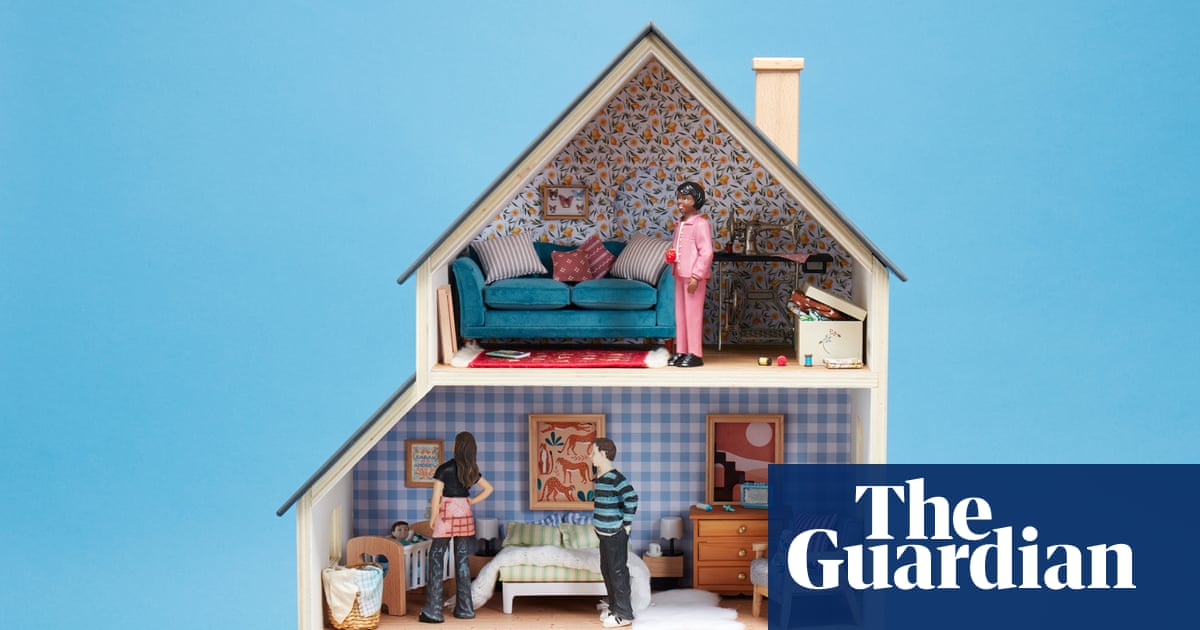
Initial residence
Prioritize the bathroom renovation
Following your home purchase, funds may be tight, but when it comes to a fixer-upper, Simon Ribchester, lead designer at Beams, recommends focusing on the bathroom first. “An old bathroom with faulty plumbing can turn into a costly issue if not addressed. Despite the mess throughout the house, having a clean sanctuary for unwinding with a wine bath is priceless,” he remarks.
Select the appropriate whites
Avoid the temptation to saturate all walls with stark white immediately upon moving in, suggests interior designer Rebecca Constable. “Although it appears as a blank canvas, it can render the space uninviting and chilly,” she clarifies. “A neutral hue like Farrow and Ball’s Wimborne White, or an equivalent match, provides a softer, more tranquil ambiance.”
Avoid getting too caught up in trends …
A frequent beginner’s error is to wholeheartedly embrace a trend, according to Ribchester, who advises treating costly fixtures and finishes (like tiles, taps, flooring) with the same caution as you would inking a tattoo: if it seems trendy and likely to fade, skip it. Enjoy experimenting instead with easily replaceable items like soft furnishings, artwork, and paint (note that darker shades are pricier to repaint).
… or restrict yourself to a few stores
Another typical misstep is to furnish entirely from a select few shops—creating a well-curated room hinges on diverse elements that showcase your personality, Ribchester explains. Incorporating something vintage that might not perfectly match—perhaps a college poster or a beloved chair—can add depth and character.
Invest in movable items
“Custom cabinetry is excellent for small living spaces, but it’s pricey and non-portable,” Constable states. An antique cabinet or a sturdy chest of drawers is typically more affordable and, unlike flat-pack furniture, is built for durability and repair, allowing it to travel with you—check out eBay, Facebook Marketplace, or The Saleroom.
Be cautious with pricey sofas
Constable warns against depleting your first-home budget on an extravagant sofa. “It will probably end up being the wrong size or shape for your next living space.” Opt for a secondhand sofa and direct your budget toward a high-quality armchair—“which will also be more affordable to re-upholster in the future.”
Opt for large rugs
If your budget doesn’t permit floor changes, procure the largest rug feasible, says Constable—your furniture should rest on it, not around it.
Take your time
Above all, exercise patience, advises Gemma Luteijn, interior designer at Project London: “The finest homes develop gradually and appear naturally curated, rather than hastily assembled.”
First child
Focus on your room’s decor first
With a baby on the horizon, your social media is probably inundated with images of pastel nursery transformations. “The most frequent error is decorating for the infant,” Constable remarks, “but they’re only a baby for a short time.” Many babies spend the initial six months in their parents’ bedroom, says Ribchester, so prioritize that area first. Enhance comfort and luxury with high-quality bedding, a cushioned fabric headboard, and a harmonious pair of dimmable lamps for nighttime feeds (a touch-base lamp with adjustable brightness settings can be less cumbersome than searching for a switch). If space allows, a bedside chest of drawers can be more useful than a small table, providing ample space for baby necessities. “Additionally, invest in a stylish lidded basket for storing dirty clothes and muslins,” he adds.
Select wallpaper thoughtfully
When decorating the nursery, consider an older child’s perspective, suggests Constable: “Large motif wallpapers may be charming but quickly become outdated. I would opt for a subtle pattern instead.” Sandberg has a selection of neutral gingham and fine stripes which will remain suitable as your child grows. A fabric canopy above the bed is a temporary fun addition—mounted with a single ceiling hook, it can be removed when your child outgrows it: “We recently added a circus-themed one to a child’s bed,” shares Gemma Holsgrove, design director at Sims Hilditch.
Avoid purchasing specific kids’ furniture
“Instead of opting for a short-lived changing table, think about an antique chest of drawers topped with a removable changing mat,” suggests Luteijn (look for patterned options that complement the room’s colors), and rather than buying a children’s wardrobe, modify a standard one with a second rail which can be removed as they grow older, Constable advises. Also, skip the toddler bed; instead, choose a regular single bed with a removable safety rail. “Upholster the headboard in a luxurious dark fabric” ensuring it’s durable as well as soft enough for bedtime stories.
Teens
Allow them some influence – within limits
“Privacy and freedom are critical for teenagers, so involve them in their room’s decor,” Ribchester states. Yet remember that teenagers can be transient, so if you’re uncertain about their lasting enthusiasm for all-black walls, stick to a neutral foundation, Constable notes: “Incorporate a color they adore in their headboard or pillows, then give them freedom with a cork wall or sizeable fabric pinboard.” Zara Cowen, an interior designer at Huxley Home, suggests a custom neon sign is more affordable than you think, providing a stylish way to showcase their name or a favorite motto: “They often suit the awkward wall space above the door.” Removable peel-and-stick decals offer a temporary alternative to wallpaper.
Ensure their clothing has adequate space
Cowen also endorses Hafele metal wire drawers, which can be installed in wardrobes: “Air circulation is crucial around that T-shirt that couldn’t make it to the wash, and basket drawers are easier to rummage through than shelves.”
Mix bedding patterns
To create engaging bedding, Cowen proposes Piglet in Bed’s mix-and-match collections, which allow for seasonal changes for a refreshed appearance.
Prepare for future electrical needs
If you’re undertaking any rewiring, Luteijn advises planning electrical outlets accommodating a double bed (even if your child currently uses a single), facilitating the transition to a guest room as they move out.
Avoid complete openness
If renovating downstairs, consider a “broken” layout over totally open space, as Constable suggests: “In a typical Victorian house with a double parlor, consider incorporating pocket doors to maintain separate rooms when your children get older.”
Establish a distinct study area …
While teens aren’t traditionally known for tidiness, a well-lit desk free of excess clutter is essential for concentration, according to home organization specialist Vicky Silverthorn, so select furniture with numerous drawers below instead of shelving above.
… along with a secondary space downstairs
“The workplace body doubling concept indicates that productivity increases when we work alongside others, which applies to teenagers as well,” Silverthorn notes. Aim for a second study area adjacent to the living room, even if it’s a nook under the stairs, where they can work while still being part of the family; a vintage drop-leaf desk is a clever way to manage clutter when not in use.
Establish a no-phone area
Given the ongoing struggle for control over screen time with teens, consider designating one room or space in the home as completely phone-free, Cowen advises—like a reading corner lined with bookshelves, or a table for board games. A specific drawer or shelf in the kitchen for charging phones can promote this. You might even find decorative “unplugged” boxes for phones to store their devices—if you find the styles too cheesy, create your own using a beautiful marbled storage box.
Nest-leavers
Prioritize comfort
As you’ll be spending more time at home, focus on comfort just as much as aesthetics, Ribchester advises. For upholstery, select plush and soft materials, “the type of fabric you may have avoided for years due to spills.”
Plan for the future
Consider longevity when selecting a new sofa: “Heavy feather-filled cushions can become increasingly difficult to lift and fluff as you age. A foam center wrapped in feathers is more sensible,” Constable highlights. Items that offer a bit more “bounce” than ‘“sinking” will be easier to navigate in the coming years. Similarly, for bathrooms, “adding a tiled bench in a shower or a broader tiled ledge around a tub enhances usability without feeling overly customized,” explains Grazzie Wilson, head of creative at tile manufacturer Ca’ Pietra. “Choose tiles with an R10 or R11 slip resistance rating for safety,” she adds. If budget permits, adding underfloor heating in the bathroom can alleviate cold mornings and quickly dry out slippery puddles, Cowen suggests.
Design with your back in mind
In the kitchen, Cowen recommends installing an eye-level oven to avoid bending; the Neff Slide and Hide makes for a solid choice in tight quarters since the door tucks under the unit. Maximizing kitchen drawers can minimize the need to bend or stretch to retrieve items lost in cupboards.
Retain elements of the past
While it’s tempting to start anew when the children leave home, keeping reminders of history can be comforting. Ribchester shares that one client, while renovating the bathroom, requested builders to preserve a Stüssy sticker that her son had placed on the window frame decades prior.
Craft a wall of memories
Considering downsizing? “Wall space is at a premium, so utilize your walls effectively,” advises Silverthorn. Photo frames that lack surface space can be repurposed into a family gallery wall, which looks particularly appealing in transitional spaces like hallways or landings. For items you can’t keep, Silverthorn suggests Vintage Cash Cow, which will sell your possessions after valuing them through experts.
Make unused spare-room space functional …
If you’re not downsizing, enhance the efficiency of your spare bedrooms by making them multipurpose: create a craft room equipped with a sofabed, or a dressing area with a hidden pull-down Murphy bed, like this innovative design by influencer Jen Rothbury. Guest rooms are also gaining popularity among clients with adult children as a lively way to welcome family: “We recently crafted one using off-the-shelf bunk beds, which we covered in MDF and painted with a whimsical cloud pattern to make them appear custom,” explains Ribchester. Alternatively, Cowen suggests Ikea’s stackable single beds as a clever solution to host grandkids.
… and personalize your bedroom
For your own sleeping area, consider small luxuries like a tea-and-coffee station tucked away in a wardrobe for an early morning beverage without needing to head downstairs, says Cowen. Sleep can decline with age, so implement blackout curtains if you lack them, and—if your mattress has seen as much use as your marriage—consider a zip-and-link model with separate spring units to minimize disturbances to your partner. “One client even had me design two identical master bedrooms,” Cowen recalls, “so neither felt they were displaced at night due to the other’s snoring!”

